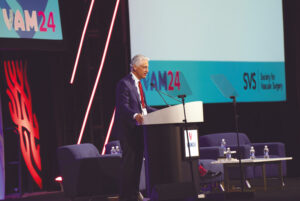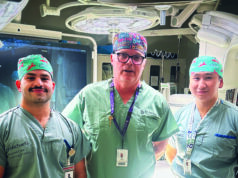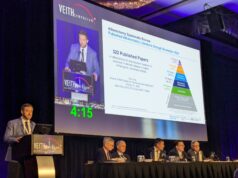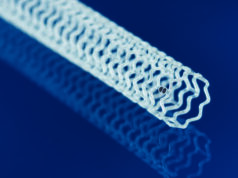
Huge opportunities abound for vascular surgeons to take a leadership role on the frontlines of a developing peripheral arterial disease (PAD) treatment crisis in the U.S., says Michael Conte, MD, who gave the second annual Frank J. Veith Distinguished Lecture at VAM 2024.
Conte, speaking on “The State of PAD Care in the U.S.,” called on vascular surgeons to take a leadership role amid great unmet need among a population who face a significant public problem during the talk in Chicago.
“There are a lot of exciting developments, and vascular surgery really needs to seize the day to lead in the science, lead in the challenges; it’s core to what we do, it’s core to our patient population,” the professor and chief of vascular and endovascular surgery at the University of California San Francisco (UCSF) told Vascular Specialist on the VAM 2024 sidelines.
“I think it’s a really great time for vascular surgeons to get involved, whether that’s in the clinical research, the disparities and access to care issues, amputation prevention programs, or multidisciplinary care.
“There’s a lot there for young vascular surgeons to embrace,” Conte continued. “The service part as well as the research part are significant. So, if you look at what’s happening at the SVS with the VISTA [Vascular Volunteers In Service To All] program [now known as Vascular Care for the Underserved], all the way through to promoting clinical trials in PAD, this is the time—it’s a generational thing.”
With carotid disease now “pretty stable,” as Conte described it, and with the strides made in aortic disease treatment meaning “we’ve solved a lot of stuff” in that domain, he said many roads now lead to PAD, which he labeled “huge” and in need of “a lot of help.”
First comes the opportunity, Conte declared, then the nature of the growing, countrywide public health problem— advancing age, diabetes not abating.
“We need to embrace and promote science-guided, evidence-based practice,” he says. “To do that, we have to continue to try to execute on designing and executing clinical trials using our registries to address important issues of quality of care, and continue to write and update meaningful practice guidelines. It’s a multispecialty space and we should embrace that, not shy away from it. We should just lead.”
During the Veith Lecture, Conte outlined the breadth of the challenges and opportunities at play in PAD treatment. He demonstrated the public health magnitude, the disparities in access to care and health outcomes, and the need to improve available therapies owing to persistent gaps in outcomes.
“What I really want you to take home from this is that in this tremendous field full of opportunities for vascular surgeons at every level, and particularly young vascular surgeons, to embrace and lead,” he implored the VAM 2024 audience.
Conte emphasized the need in the U.S.: “While we were doing really well with cardiovascular mortality, going from the 1980s to the early part of this decade, since 2010 things are going backwards. Cardiovascular mortality rates for both men and women have been back on the rise for the last 10 years, and there is a geographic distribution to this as well.”
After some decades of improvement in overall amputation numbers, those too are rebounding, Conte pointed out. Many are minor “but reflect the growth of diabetic foot disease overlaying with PAD. Those two things in concert have really taken over our practices. We are seeing many, many patients with neuroischemic wounds and diabetes, and a rise in the need for limb amputations.”
Conte turned to disparities in outcomes and the severity of disease, which “is certainly not equally felt by people of all races, colors and creeds.”
He said, “We have a lot of work to do to address the unbalanced proportion of Black and Hispanic patients who are presenting at late stages of disease and are at higher risk for amputation than their White counterparts.”
Economic disparity overlays with racial disparity, he continued. Similar overlays can be demonstrated with food and housing insecurity, Conte said, “highlighting the fact that some of the racial and ethnic disparities are tied into social determinants of health. And until we tackle all of that together, we’re probably not going to be able to make a dent in some of this disparity.”
He pointed to a number of advances in medical therapy for PAD, referencing a change in the approach of the pharmaceutical industry to approach the disease process as an entity in its own right, separate from coronary disease. “Overall, this is a huge change in opportunity but it requires a lot more education and public awareness to transfer this to effective outcomes for patients,” Conte said.
He also addressed access, appropriateness and value issues in vascular care. “It’s difficult to say where we are,” Conte reflected. “Too little care or not enough care? ”The issues within this conundrum must be tackled “head on,” he implored.
In sum, Conte emphasized vascular surgery’s lead role in PAD care delivery, science and innovation—”but multidisciplinary collaboration is fundamental to success.” The SVS should lead by fostering clinical excellence, education, science and building community across all PAD stakeholders, he added.












